Nov 12, 2025

Are you sure you’re making the right investments to help your crops reach their full yield potential? You likely invest in good, reputable seeds and seed treatments to deter pests and pathogens. You also probably invest in inputs to ensure the crop is protected and supported to reach its maximum yield potential.
Yet, if none of your inputs reduce your plant’s abiotic stress, your crops can’t reach their full potential–you’re leaving money on the table. After all, it’s incredibly disappointing to invest in multiple inputs only to watch your yields dry up due to the stress of limited water or excess heat.
By supporting the microbes in the phyllosphere, growers can mitigate abiotic stress, grow healthier plants and improve yield potential. It all starts with providing these helpers with a well-balanced meal.
There are four interconnected “spheres of influence on a farm, all of which influence the other, and impact productivity and yield potential.
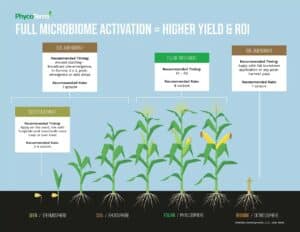
This short-lived yet impactful sphere is your seed’s first interaction with the real world, found in the 2- to 12-mm area around the seed. Beneficial microbes in this sphere support germination, early plant vigor, root-structure development and crop establishment.
When the microbiota (bacteria and fungi) in this sphere are abundant and active, it creates an ideal environment for seeds to grow.
The rhizosphere consists of the soil around plant roots. An abundant (number/amount), active and diverse (different types) soil microbiome assists with increasing organic matter, increasing NPK, improving soil aggregates, improving water holding capacity and more.
The detritusphere is a soil habitat formed by decaying organic matter. Your fields are full of crop residue post harvest, like cornstalks and residual roots. This residue stimulates beneficial microbes, which go to work breaking down organic matter and cycling nutrients.
The phyllosphere is a region around the leaves and above-ground plant tissue where microbes live. On a 1cm2 of leaf surface or the area the size of your thumb nail, you can find 10 million bacteria and 1 million fungi, colonizing in the in (endophytes) and on (epiphytes) the leaf. It is the only sphere where plants, microbes, and the atmosphere all interact.
Beneficial microbes act as a line of defense against pathogens. They provide multifaceted performance benefits to the plant, positively influencing the nutrient exchange, plant metabolism and stress tolerance. In exchange for supporting plant immune response, plants provide microbes with spacious living accommodations.
The phyllosphere microbiome is impacted by many factors and is one of the harshest spheres for microbes to live in.
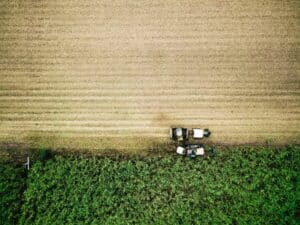
While farmers are often well-read scientists, it’s not surprising if the phyllosphere is a new term to you. The phyllosphere has also been ecologically neglected compared to the other spheres. It was originally defined in the mid-1950s but is now recognized as highly relevant for food safety.
What we do know about this sphere is that it is one of the most dynamic regions on the plant, including a harsh, unpredictable environment. Some of the variables that impact the composition and diversity of the microbiome include:
This sphere, in particular, is also a food desert. Many of the beneficial microbes in the phyllosphere are inactive, or asleep. It’s ideal for any farmer to make a plan to feed, and wake up, inactive microbes so they can get to work supporting crops.
A diverse and active phyllosphere microbiome provides three main benefits for crops.
When crops are less stressed, resilient to disease and absorbing more nutrients they’re able to produce higher yields and healthier crops.

The biggest limiting factor of microbe growth on the leaf is a lack of a carbon-based food source. In this particular sphere, bacteria and fungi have limited access to carbon, nitrogen and micronutrients. Without a proper food source, they’re unable to maximize nutrient availability and improve abiotic stress tolerance.
A food source like PhycoTerra FX provides beneficial microbes in the phyllosphere, a well-rounded food source, putting those bacteria and fungi to work. Once applied, active and diverse microbes improve nutrient acquisition, plant health and abiotic stress relief while directly impacting plant yield.
There are other practices that can benefit your phyllosphere microbes too, like implementing these practices or supporting the microbes in one of the other four spheres, given that all the spheres on your farm are connected and impact one another.
While all crops can benefit from phyllosphere management, our trials show that corn, soybeans, wheat and cotton, in particular, benefit from a well-rounded food source.
If you’ve never fed your phyllosphere microbes, they’re hungry. That said, microbes on farms that practice regenerative farming practices are more likely to be awake and active. Regenerative practices, like low-tillage and cover cropping tend to support and feed beneficial microbes in all spheres.
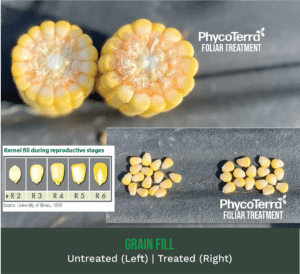
A well-rounded food source applied to the phyllosphere benefits corn from R1 to harvest. Growers can see a notable difference at R1, R2 and R3.
R1: At this phase, corn is vulnerable to heat, drought and insects, all of which can greatly impact yield. This is also when water requirements peak at .33 inches per day.
R2: At this phase, cell division is completed. Yet, kernel abortion is at a high risk.
R3: Kernel abortion is still at a high risk as grain fill is developing.

With an abundant and active phyllosphere microbiome, plants are less stressed, allowing them to focus their energy towards kernel production, impacting yields by +15%.
This improved plant health is linked to increased grain fill. Greener leaves and stronger stalks improve photosynthesis and have better water uptake, producing larger kernels. The health of the overall plant can impact grain fill variation and yields by up to +40%.
Once your corn has reached maturity, sustained plant health optimizes late season harvestability and reduces yield loss. Healthier plants, stand longer and hold up to adverse harvesting risk better than weak or stressed plants.
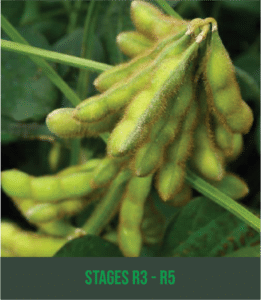
Like corn, a well-rounded food source can also help soybean crops improve yield potential. From R3 to harvest, an active phyllosphere can make a notable impact.
R3: At the beginning of pod formation, pods are ¼ inches long at one of the four uppermost nodes from the main stem. Plants that experience water stress can impact pod formation.
R4: Disease and insect pressure have a major impact on yields at this stage. Water requirements peak at .43 inches per day.
R5: At this stage water and nutrients are crucial to development. Root growth is also active, and shallow roots can lead to degeneration.
When phyllosphere microbes are fed at R3 to R5, pod formation is improved by mitigating water stress. This is key for developing more and larger pods.
At harvest, plants that had an abundant and active microbiome had greener leaves, larger soybeans, stronger stalks and fuller canopies. This allows the plant to maximize photosynthesis and water useto increase pod fill and yield. By maximizing plant health and standability, plants are able to resist lodging, maintain pod integrity and hold up to adverse harvesting risk later in the fall.
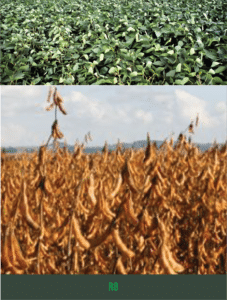
While there is less research and studies done on the phyllosphere compared to the other four spheres, all the information we have at the moment suggests the phyllosphere plays a crucial role in plant and crop development. An investment in a well-balanced food source for the phyllosphere could be the difference between a lackluster year and a high-yield year, especially for corn, soybean, wheat and cotton farmers.
Ready to put your phyllosphere microbes to work? Fill out a contact form, and a PhycoTerra team member will be in touch about the impact PhycoTerra could have on your farm.
All data is from March of 2025. For updated metrics, please visit our trials page.